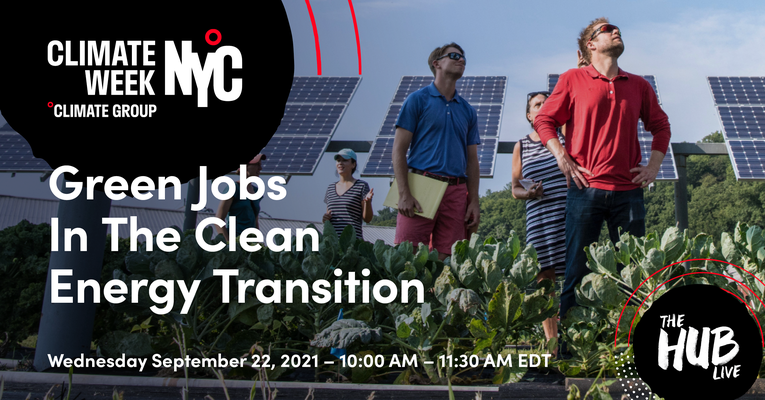This year, US President Biden pledged to transition the country’s energy supply to 100% clean energy by 2035. This historic commitment has the potential to create over 10 million green jobs.
Around the world, a further 30 million new renewable energy jobs are expected in the next decade. This represents a critical opportunity to change how energy workers are valued while also helping the planet. How can we ensure that people thrive in the just energy transition?
Leaders spoke out about centering equity in our climate change measures
Secretary of the US Department of Energy Jennifer Granholm and Secretary of the US Department of the Interior Deb Haaland were joined by over a dozen experts from industry, labor and government to talk about just that at “Green Jobs in the Clean Energy Transition,” a Climate Week NYC’s The Hub Live event.
“We have to put humanity at the heart of our transformational leadership and become ten times bolder to get from here to shared prosperity on a healthy planet,” said CEO and Chief Change Catalyst of the B-Team Halla Tómasdóttir.
On a planet in crisis, everyone has to act now
Panelists spoke passionately about the need for government, industry and the public to take decisive and immediate action.
“The time to transition to a clean energy future could not be more urgent,” said Haaland. “We are seeing the impacts from climate change more than ever before. Wildfire seasons that seem to never end, extreme hurricanes, severe drought, heat waves in places that have never seen them before…We are facing a climate crisis.”
Staying mindful of many moving parts will be an important element of this transition
To keep climate change to just 1.5 degrees, we need to pull out all the stops, said Mary Warlick, deputy director general of the International Energy Agency. “It is technically feasible but there is a narrow pathway to a 1.5 degree scenario world,” she noted. “In order to achieve that goal, we need immediate action now until 2030.”
To do that, we have to deploy all current technology and invest in future tech. But, she explained, it’s also critical that we center the workers, citizens and communities who will face the impacts of this massive restructuring of the energy sector and ensure that the transition is also focused on equity, inclusion and affordability.
Jobs have to be top a priority in all clean energy plans
The renewable energy transition needs to be done with “good paying, family sustaining jobs” in mind, said Granholm, who wants fossil energy workers to have a seat at the table to help plan how their industries will reskill for the green energy future.
Labor unions are also being given a critical role in transition planning, because “when the labor community is weakened, inequality grows,” Granholm said.
The promise of more unionized energy jobs is just one reason why James Slevin, national president of the Utility Workers Union of America, is supportive of the clean energy pledge. He is also concerned about the impact of climate change on his members. “We know there are no good jobs on a dead planet,” he said. “If we keep destroying this planet there will be no places for our members to work.”
Low-income and disadvantaged communities cannot be left behind
Many of the federal clean energy programs in the works are focused on creating jobs in low-income and disadvantaged communities to ensure that those typically affected by environmental injustice benefit.
“We need a different economy where we bring everyone together…It’s not just about jobs: it’s about people in our society,” said President and CEO of the World Resources Institute Ani Dasgupta.
Global energy policy also has to be a focus
While many panelists concentrated on the need for change and job growth in the US, Damilola Ogunbiyi, CEO and special representative of the UN Secretary-General for Sustainable Energy for All (SEforALL) and co-chair of UN-Energy, reminded listeners that we need to also focus on global energy inequality.
“About a third of the world’s population have no access to clean fuels,” she said. “It’s energy to do stuff…it’s energy to live a dignified life, it’s energy for health care…it’s not the minimum amount of energy but energy that you can actually develop out of poverty.”
Dasgupta agreed: “We will not be able to hit our common goals for net zero by 2050 if we do not provide safe, clean and affordable access to electrification and clean cooking solutions to everyone on the planet by 2030.”
For a just transition, that will have to translate to clean energy jobs in those communities, too.
The clean energy future is a great future
Basil Seggos, commissioner for the New York Department of Environmental Conservation, said that he is hard at work ensuring that the green energy transition in his state results in everyone winning and no one losing. This approach is something governments, non-profits and business alike must strive for.
“I have to be stubbornly optimistic that when all the science and technology and workers are on the same page, we’re ready to have a great future,” he said.
